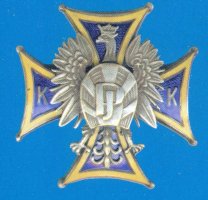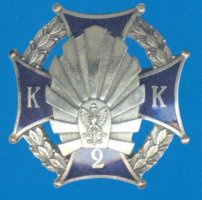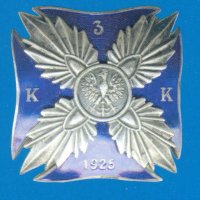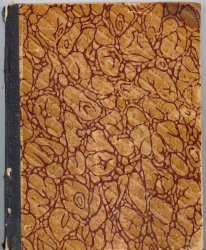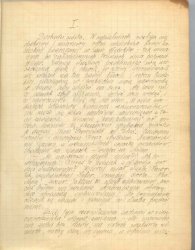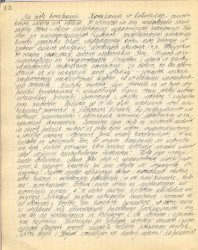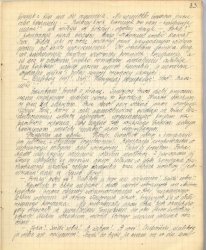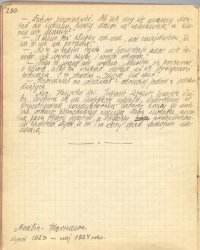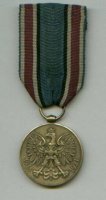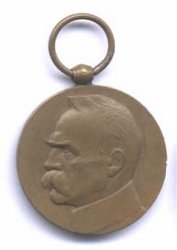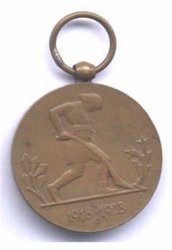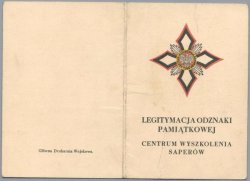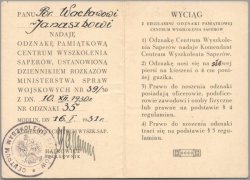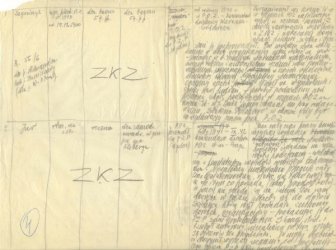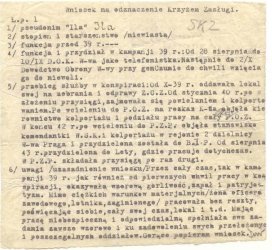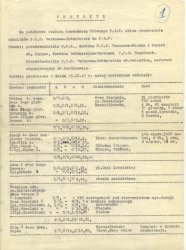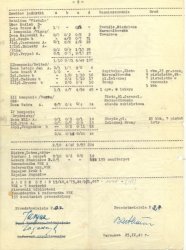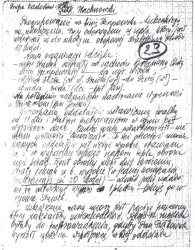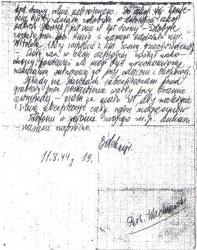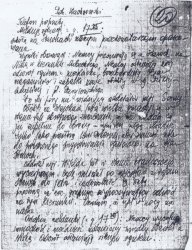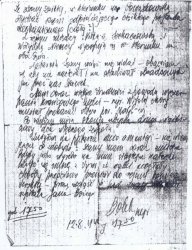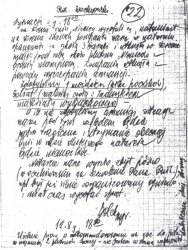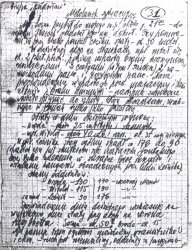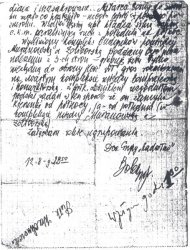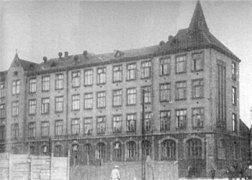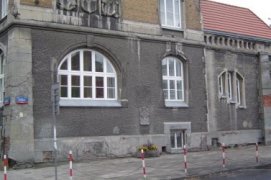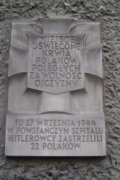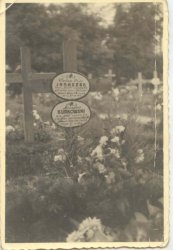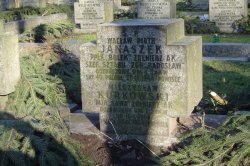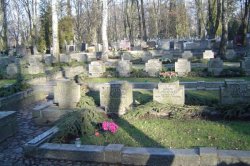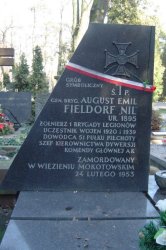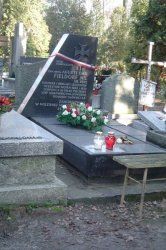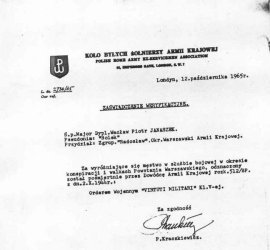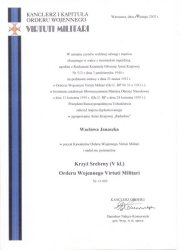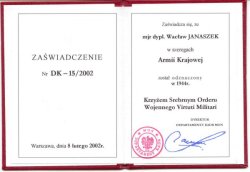The years 1903 - 1939
Wacław Piotr Janaszek was born on December 1, 1903 in Radom as a son of Józef and Genowefa, whose maiden name was Kubicka. His father was working as a railway official. Like in many Polish families, Since his childhood Wacław had been brought up at home filled with patriotic spirit, the spirit of Poland and love for the homeland.
A Wacław's uncle, his mother's brother, was a Sandomierz bishop, who himself brought out a trick study, consisting of five volumes of archival materials, presenting the Polish priests' resistance showed towards the foreign authorities in both Russian and Prussian sectors of partitioned Poland. His patriotic behavior was publicly appreciated in one of the pronouncements of the President Ignacy Mościcki. Another family member, an uncle - chemist - a revolutionist of the year 1905, took part in preparing terrorist actions against the czar authorities. Captured during a First May march and put in a Warsaw Citadel he died being 30 years old, At liberty, suffering from serious after-prison tuberculosis.
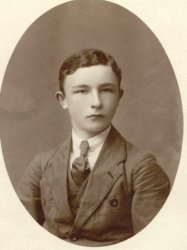
Janaszek - a young boy
Wacław started his school education in Radom. After the WW I broke out, his father as a railway official, in the year 1915 was evacuated together with his family up-Russia. Wacław was learning at a Kiev gymnasium and then in Woroneż. In the year 1918 r. the family came back to Radom and here Wacław continued his education at a gymnasium. In the year 1920 he joined the Cadet Corps.
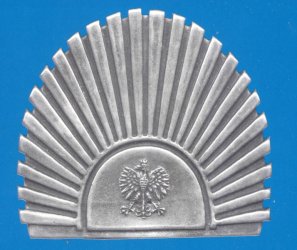
A Cadet "Sun"
After Poland regained independence in the year 1918, the first military school - referring to the tradition of the Knight School set up by the King Stanisław August Poniatowski in 1765 - was established. It was the Cadet Corps number 1 (CC1) organized on October 30, 1918. in Łobzów, close to Kraków (it was several days before the formal resumption of independence). In the year 1921. CC1 was moved to Lvov.
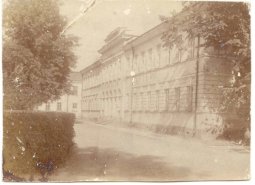
A school building CC2 in Modlin
|
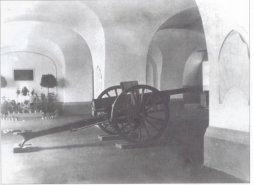
An entrance hall of CC2 in Modlin
|
On September 28, 1919 the Cadet Corps number 2 (CC2) was set up in Modlin. This was moved in the year 1926 together with its students (called elew) and its staff to Chełmno and then in the year 1936 to Rawicz. On June 17, 1925 the Cadet Corps number 3 (CC3) was established in Rawicz. After moving the second Corps to Rawicz in the year 1936, Corps number 2 and 3 were joined together under the name CC2.
Cadet Corps of the Second Republic of Poland were schools of very high standard of teaching. These were secondary schools, the graduating from which would give a maturity certificate a.k.a. Matura. A company divided into platoons was a Corps' equivalent of a class in civil schools.
Military training would fulfill the requirements of an unitarian course of Officer Cadet schools, which allow undergraduates to join the second year of these schools. A condition to be accepted was passing a difficult competitive examination. A number of candidates would always much go beyond the limits of free places. Inclusively, about 4,100 students and graduates went to the Cadet Corps of the Second Republic of Poland.
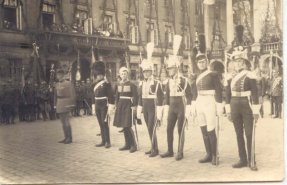
Gala clothes
|
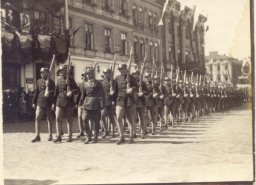
a Cadets' march
|
In the year 1920, when Poland faced the danger of the Bolshevik aggression, also the Cadet went to a fight against the Red Army lead by Michaił Tuchaczewski. A command of the Minister of Military Issues allowed cadets from the age of 17 onwards to join an active service. 181 out of 190 cadets from Modlin voluntarily, due to their own willingness and choice went to linear units.
Wacław Janaszek was among them as well. From July to October 1920 he was serving in the 3rd infantry regiment of the Academy Legion and participating in fightings on a Warsaw foreground. He was promoted corporal for the participation in the fightings.
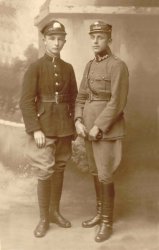
Janaszek a cadet (on left)
After a repulse of the Bolscheviks on October 4, 1920 a new school year started in Modlin. In June 1923 Wacław Janaszek, having finished the Cadet Corps number 2, gained his maturity certificate.
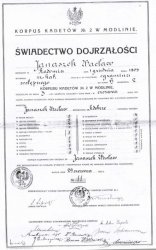
a Maturity Certificate
Immediately after finishing his studies in the Corpus, in August 1923 he enlisted in a course of supplementary training in a Infantry Officer Cadet School. He finished this course in October 1923 and gained a rank of a Corporal Officer Cadet.
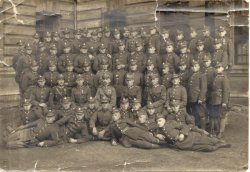
a common photography doming from a training cadet course
Wacław decided to devote himself for a military Career. In October 1923 he started his studies in the Oficer School of Engineering in Warsaw. On April 4, 1924 he became promoted Platoon Officer Cadet and on July 24, 1924 he was promoted Sergeant Officer Cadet, which was stated in an order 173/24.
Apart from typically technical interests connected with a field of his studies, Wacław would also show his humanistic talents. From January 1923 till May 1924 he was writing a book - a diary entitled "Fifth Company" that is a great document of the first years of CC2 in Modlin. In an interesting and funny way he presented cadets' everyday life, their tutors and realms of life in a free homeland. The study survived till contemporary times in a form of a manuscript.
a diary's manuscript
From September 1924 he was serving as a officer cadet in the First Company of the Seventh Battalion of Sappers in Sandomierz.
On October 1, 1925, he completed an elementary two-year training at the Officer's School of Engineering as first in the rank. On October 7, 1925, by daily order 101/25, Wacław Piotr Janaszek was commissioned as a second lieutenant permanent active duty sapper in the Corps of Engineering and Sappers of the Polish Army.
He received a merit award called "The Golden Sabre of Mr. President" at the promotional ceremony.
In the inter-war period, top students of officer's schools of the Polish Army who graduated as first in the rank received honorary awards from the President of the Republic of Poland - sabres or daggers, the honorary officer sabres, the so-called Golden Sabres of Mr. President.
This custom was introduced in 1923 by the President of the Republic of Poland Stanisław Wojciechowski.
In the whole history of the Second Republic of Poland over the years 1923-1938, the graduates of all officer's schools were awarded a total of 123 (or 124) "golden" sabres or daggers constituting the awards of the President of the Republic of Poland.
In the history of the Officer's School of Engineering, the "Golden Sabre" of Wacław Janaszek was the second in line out of 28 awarded to cadets.
Unfortunately, this exceptional family heirloom has not survived the maelstrom of war.
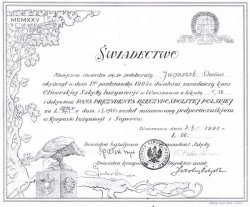
a certificate of a 2-year-course finishing
Second Lieutenant Wacław Janaszek continued his studies and on September 29, 1926, he completed a full three-year training at the Officer's School of Engineering, again ranked first.
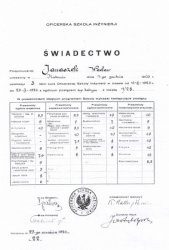
a certificate of a 3-year-course finishing
On September 30, 1926, second-lieutenant Wacław Janaszek started his service as a lower officer in the Fifth Regiment of Sappers in Kraków-Dąbie.
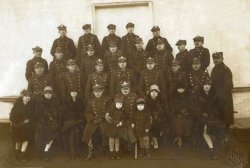
a sapper regiment staff
In the year 1927 in a St. John Church in Warsaw he got married to Natalia Goździk. On August 27, 1927 by an order 19/27 he was promoted first lieutenant of sappers in a permanent service. Since December 1927 he had served as an educational officer in the Fifth Regiment of Sappers.
In the year 1928 lieutenant Wacław Janaszek was moved to a School Battalion of Sappers in Modlin (DP 9/28 page 149).
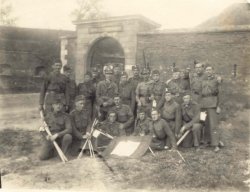
a course for the reserved second lieutenants
On November 1928 he was honored by a medal "For the War 1918-1921" (an order. 78/28), and on December 11, 1928, he Got a medal on the occasion of "Decade of Regaining Independence" (an order. 87/28).
People in command noticed over-average skills of a young lieutenant. In August 1930 he was mobbed to the Training Centre of Sappers in Modlin where -on October 17, 1930 - he became a member o fan Experimental Commission, being on this position till the year 1934.
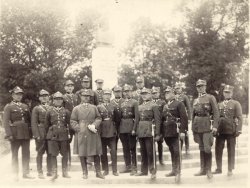
a common photography of the Training Centre of Sappers
On December 10, 1930 he gained a "Commemorative Award of the Training Centre of Sappers" number 25 (an order. 39/30).
an order of the Training Centre of Sappers
On December 12, 1931 his daughter Halina was born. Unfortunately, the marriage of lieutenant Janaszek was in a serious crisis finished with separation with his wife Natalia. On May 5, 1933 formal separation with his wife Natalia occurred (a verdict of the Court of Martial Bishop) and on January 5, 1934 Wacław divorced his wife.
From September 1934 till June 18, 1936 Lieut. Wacław Janaszek was staying in Nowy Dwór. On March 19, 1935 he was promoted captain of sappers in a constant service.
In the year 1935 he took part in maneuvers in Rawa Ruska.
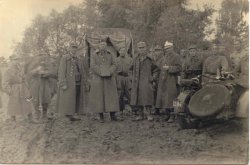
manoeuvres
From September 8, 1936 till August 9, 1937 he was stationed in an unit in Baranowicze.
He was systematically developing his professional qualifications. He started studies in the School of Engineering in Warsaw and finished them in the year 1938, having gained a title of a military engineer in a field of fortifications.
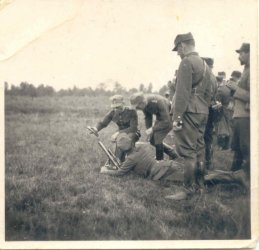
shooting exercises in the School of Engineering
This title was ratified by the Polish Government In Exile not earlier than in the year 1945 and the diploma was sent for the family many years after the war.
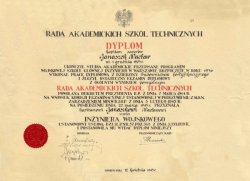
an engineer's diploma
After a short stay in Lvov from June 18, 1938 Lieut. Wasław Janaszek quartered on Bielany in Warsaw. On October 17, 1938 he was delegated to work At the headquarters of an Operational Group of the Army "Śląsk" commanded by general Władysław Bortnowski and he took part in an operation on Zaolzie.
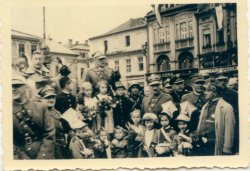
Zaolzie
Afterwards, at the end of the year 1938 he was serving at a Bridge Battalion of Sappers, being stationed in a fortress Modlin-Kazuń. On December 26, 1938 captain Wacław Janaszek got married again - to Barbara von Seydlitz. Due to formal reasons, the marriage took place in an Orthodox Church on Praga in Warsaw. A divorce with his ex-wife was validated by a metropolitan of the Orthodox Church, which allowed to get marriad again, this time in Orthodox rites.
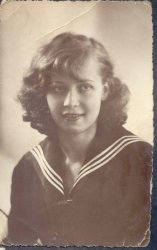
future wife Barbara
|
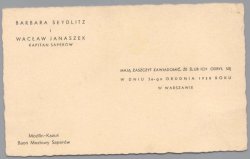
an invitation for the wedding
|
Blissful, the young married couple spent a New Year's Eve and welcomed on a ball a New Year 1939.
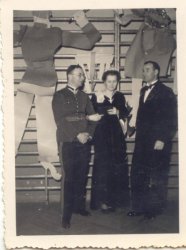
New Year's Eve
|
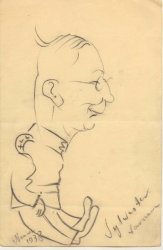
New Year's Eve - a caricature
|
In June 1939 Wacław Janaszek was serving as an officer of the Inspectorate of the Army "Pomorze" and was living At that time in Toruń in the Mostowa street number 6, apartament 9. In the September Campaign he was an officer in the sapper command of the headquarters of the Army "Pomorze" commanded by general Władysław Bortnowski.
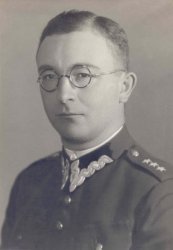
Janaszek - a captain - the year 1938
The Occupation
After the Polish army commanded by general W. Bortnowski had been defeated in the vicinity of Iłów near Sochaczew, Janaszek forced his way through the Kampinos Forest to Warsaw and took part in the defense of the capital city. After the Warsaw's capitulation, like many other Polish Army officers, he was not taken prisoner and in the autumn 1939 he started his underground activity.
At the end of September 1939, after a decision of finishing fightings for Warsaw, general Michał Tokarzewski-Karaszewicz informed a group of chosen officers that military conspiration had been established. Captain Wacław Janaszek was among these officers informed about this event. A clandestine military-political organization called the Service to Poland's Victory (Służba Zwycięstwu Polski) was established. One of its first actions was to be an attempt on Hitler's life on October 5, 1939 during a German march past of their victory in Warsaw. The attempt did not come off because the Germans emptied the streets on the route.
In the middle of October 1939 Gen. Tokarzewski informed the Commander-in-chief general Sikorski about having organized the Service to Poland's Victory (Służba Zwycięstwu Polski). Sikorski negatively concerned the concept of a political-military organisation, being afraid of too much influence of the officers of the 'sanacja' regime. What followed was dissolution of the organization and withdrawal of gen. Tokarzewski from commanding the military conspiracy in the country. Such a decision caused consternation and confusion among the officer cadre. Some officers joined other clandestine organizations supported by a political centre of gen. W. Sikorski. Captain. Wacław Janaszek was among these, too. He united with the Polish Armed Organisation (Polska Organizacja Zbrojna).
In November 1939 a youth country organisation the Central Association of the Country Youth "Sowing" (Centralny Związek Młodzieży Wiejskiej "Siew"). revived its activity in Warsaw, under conspirational circumstances. After a September catastrophe some of the organisation's activists, accompanied by other people who did not belong to the Association resumed its activity under a name the Peasants' Organisation of Freedom "Racławice" (Chłopska Organizacja Wolności "Racławice").
Officers from the constant service and from the reserve started to co-operate with "Racławice." They made a decision to create an independent military organisation on the basis of "Racławice." It came into being in the spring 1940 and got a name the Polish Armed Organisation (Polska Organizacja Zbrojna). An executive role in the organisation was taken by young officers only, who went through a September defeat and were assessing a war activity of high ranked officers quite critically. In the year 1940 other smaller underground organisations joined the Polish Armed Organisation: the polish Fighting Squad (Polska Organizacja Bojowa), the Military Organisation of Freedom "Sign" (Wojskowa Organizacja Wolności "Znak"), a part of the Armed Deed's Union (Związek Czynu Zbrojnego), a part of the Secret Army Poland (Tajna Armia Polska), a part of the National Defence Guards (Gwardia Obrony Narodowej), a part of the Military Organisation "Wolves" (Organizacja Wojskowa "Wilki") and a part of "Reveille" ("Pobudka"). A new organization, after a merger, got a name the Polish Armed Organisation "Sign" (Polska Organizacja Zbrojna "Znak").
A main commander of the Polish Armed Organisation after its formation was captain Kazimierz Różycki. With the Main Headquarters of the Polish Armed Organisation the following people were co-operating, forming its extended group, captain Wacław Janaszek (a.k.a. "Jaryna", "Radomski", "Bolek" - a Commander of the First District of the Polish Armed Organisation Warsaw -city, captain. Stanisław Steczkowski (a.k.a. "Zagończyk") -Chief of Staff of the First District, lieutenant Józef Barcikowski (a.k.a. "Hart") - officer of arms.
The Polish Armed Organisation assumed the whole German-occupied Poland (1939-1945). After having announced that the Main Commander of the Polish Armed Organisation W. Sikorski, the Commander-in-chief of the Polish Army acting in the West would be, joining volunteers were treating the organization as the Polish army in conspiracy. The Polish Armed Organisation reached a number of c. 55-60 thousand of members.
The First District of the Polish Armed Organisation Warsaw-city was organised at the beginning of the year 1940. An organizer and a commander of the district, captain Wacław Janaszek (a.k.a."Radomski", "Jaryna", "Bolek", and "Wacek") simultaneously was a member of the Main Headquarters of the Polish Armed Organisation, performing duties of a chief of the Department of Sabotage and Diversion.
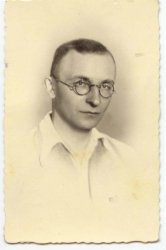
Janaszek - the year 1940
A Chief of Staff was captain Stanisław Steczkowski a.k.a. "Zagończyk", a chief of Espionage and Counter-Espionage was captain. Wacław Chojna (a.k.a. "Świerczyński", "Świerk", "Majewski", "Młotek" and "Horodyński"). Such a complete Staff was acting in a period of March 1940 till December 1941. The liaison officers were: Barbara Janaszek a.k.a "Basia" (a wife of W. Janaszek), Urszula Tynelska-Zbichorska a.k.a "Ula", as well as Małgorzata Zakrzewska.
proposals of promotion for POZ soldiers
After the Service to Poland's Victory had been dissolved in November 1939, the Association of Armed Fighting was brought into being, totally subordinated to the emigration government. At first it was acting as a closely conspirated cadre organisation forming the command of areas, districts and outposts as well as special units. Its total numerical force was about 3 thousand members. Increasing this state was to occur thanks to merger of other military organisations' members.
Despite first suspicion of the young officer Staff, the Polish Armed Organisation started co-operation with the Association of Armed Fighting. Within the latter one the Association of Retaliation (later Kedyw) was created in April 1940, which was doing sabotage-diversion operations (commando troups). A Commander of the First District of the Polish Armed Organisation Warsaw-city, captain Wacław Janaszek was also there. Among his duties there was coordination and tactical-operational cooperation as far as actual active fighting was concerned.
In spring 1940 the Polish Armed Organisation behaved in a loyal way and agreed with instructions given for the Main Commander of the Association of Armed Fighting Colonel Stefan Rowecki that ordered to subordinate all the conspirational military organizations to him and started cooperation with that organization.
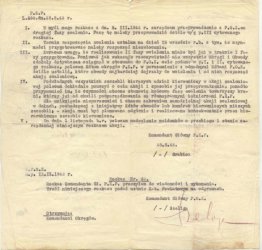
gen. Rowecki's order
In a period between September and November 1942 the First District of the Polish Armed Organisation was included into the Home Army, which the Association of Armed Fighting was transformed into in February 1942. Some part of the organizations soldiers had been yet before moved to a field of diversion. According to the data of relating official records that saved in a secret occupation registry of W. Janaszek a total number of about 4 thousand officers, officer cadets, non-commissioned officers and the men from six Warsaw districts and the Warsaw administrative district were directed to the Home Army. These were units of big conspirational practice, well trained and with quite big supplies of arms.
documents of merger
On May 5, 1941 an order L. 21/BP made captain Wacław Janaszek major of sappers in the constant service. After the First District of the Polish Armed Organisation had been included into the Home Army major. Wacław Janaszek thoroughly moved to work in Kedyw of the Home Army's Main Command.
Organising of Kedyw started In November 1942. On January 22, 1943 the Home Army's Commander general S. Rowecki a.k.a. "Grot" gave an order number 84 entitled "The arrangement od the field of active fighting." It ordered to create the Diversion Supervision "Kedyw." The entire "Kedyw" included the up to then Organisation of Revenge "Range" as well as Shock Troops of the "Grey Ranks" (underground scout organisation)
The Kedyw of the Main Command of the Home Army' task were, among the others, as follows:
- Planning diversion and sabotage actions in the country,
- Supervising the actions of Discretionary Units of Kedyw,
- Studying the methods and ways of organisation diversion, sabotage and partisan's actions, working out and giving instructions,
- Instructing commanders of teams and diversion patrols as well as technical instructors,
- Main production of means of sabotage-diversion fighting.
In the foreground of Kedyw of the Home Army's Main Command stayed a Commander supervising the totality of the Home Army's fighting and directly subject to the Main Commander of the Home Army.
In a period between autumn 1942 and February 1944 the Kedyw commander was Colonel August Emil Fieldorf a.k.a. "Nil."
From February 1, 1944 lieutenant-colonel Jan Mazurkiewicz (a.k.a. "Sęp", "Zagłoba" and "Radosław") was appointed a Kedyw Commander. The second-in-command from a moment of creating Kedyw till September 1943 was lieutenant-colonel Franciszek Niepokólczycki a.k.a. "Teodor", and then till February 1, 1944 - lieutenant-colonel Jan Mazurkiewicz, before being appointed a Kedyw Commander.
A post of the Chief of Staff of Kedyw In the Main Command of the Home Armyall that time belonged to major Wacław Janaszek a.k.a. "Bolek."
While analyzing conspiration activity of major Wacław Janaszek one ought to take into consideration the situation in which it was being done. A professional officer, living in succeeding tied flats before the war, living a peaceful, prosperous life, having an orderly at his disposal, found himself in totally new conditions for him - conditions of permanent changes, uncertainty of tomorrow, improvisation connected with a moment's need and constant danger. Here are addresses of succeeding tied flats in which he was staying with his wife and his daughter: Siennicka, Kazimierzowska, Staszica and Stalowa at last.
His succeeding pseudonyms: Wacław Seydlitz (a maiden name of his wife Barbara), Franciszek Łyżniak and Wacław Wolski. He had faked Kennkarten for each of these names, as well as certificates confirming false employment, birth certificates were made by legalization cells of the Polish Armed Organisation, and then by the Home Army. He was also using man,nay succeeding conspirational pseudonyms: "Radomski", "Jaryna", "Boryna", "Wacek" and "Bolek".
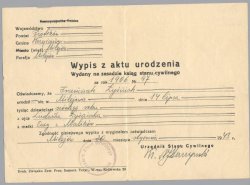
|
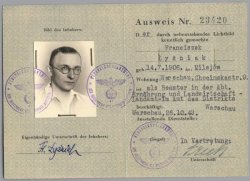
|
faked documents for the surname Łyżniak
Since the beginning of the occupation till spring 1940 he was living at his wife's relatives the Garleys in the Siennicka street number 9 in the Grochów district. He made his host join the conspirational activity In the Polish Armed Organisation (two sisters and one brother). In April 1940 he hired a room in the Kazimierzowska street number 69 on the Mokotów district at a Gymnasium named after Adam Mickiewicz Professor's Mr. Stefan Essmanowski. The Janaszek family was registered there as Seydlitz siblings, two sisters and one brother.
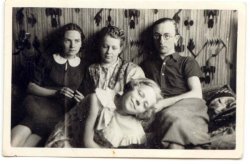
Janaszek with his wife and daughter In the year 1940
At the Essmanowskis' captain Wacław Janaszek got to know oficer cadet Michał Wojewódzki, an authot of a book entitled "In secret Warsaw painting houses 1939-1945", whose tutor in a gymnasium was Professor Essmanowski. Michał Wojewódzki a.k.a. "Andrzej", a later supervisor of an underground painting house, took part in the defence of Warsaw in the 21st Warsaw Infantry Regiment. Having got to know him more closely, Wacek proposed him to join a conspirational military organisation. In that way Michał Wojewódzki became a member of the Polish Armed Organisation.
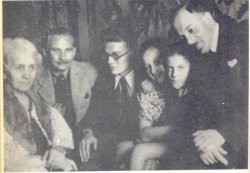
Janaszek and Essmanowski families
Wacek, acting under a pseudonym "Jaryna", administered an oath to him: "Aware of responsibility for the fate of the Polish nation and country, I'm joining the Polish Armed Organisation. I swear to guard an organisation's mystery, to reliably exercise given superiors' orders and tasks and, if necessary, to testify my life to my oath's faithfulness. So help me God."
First Michał's tasks were to train young people on the Żoliborz district (where the 21st infantry regiment "Warsaw Children" was stationed) how to deal with shooting arms. Wojewódzki was still thinking about work in underground press. In winter 1940 he unfolded his dreams to Wacek Janaszek. The latter, knowing that Michał knew the German language, proposed that he could prepare short materials in the military nature worked out on the basis of the German Press. They were later placed in a clandestine biweekly publication entitled "A Polish Soldier."
Captain Wacław Janaszek, apart from supervising the first District of the Polish Armed Organisation Warsaw-city and his work in the Association of Armed Fighting, was an editor-in-chief of "A Polish Soldier" as well. He created this publication in February 1941. This was a technical magazine of the Polish Armed Organisation, containing descriptions of particular types of weapons and instructions of their service. Articles reflecting upon a political situation in a particular war period were put in it, too. At first, it was a biweekly publication of a circulation up to 12 thousand issues. It was taken by means of a distribution network. After inclusion of the Polish Armed Organisation to the Association of Armed Fighting a task of editing "A Polish Soldier" was taken over by Michał Wojewódzki. The monthly became one of the Home Army's organs.
One day in February 1941 Wacław Janaszek met in the Nowy Świat street his colleague, an ex-officer. The man was trying to get to a closer contact with him in an intrusive way. He was speaking in an obscure way about conspirational work and asking about old friends. After having found more about this man later on, Wacek was advised to rather avoid him because of a suspicion of his collaborating with the Germans. Just in case captain Janaszek left the Essmanowskis' flat and changed his surname. From now on his name was Wacław Wolski, Barbara was officially his wife again, and Halinka - his daughter. For a short time they were living in a soap factory's premises in the Staszica street and then they moved to the Praga district to a flat in the Stalowa street number 47. Still after several post-war years old tenants remembered the wife of Wacław Janaszek as Mrs. Wolska.
In such conditions succeeding occupational years were passing by, which of those could have ended tragically. In January 1943 the Chief of Staff of Kedyw major Wacław Janaszek "Bolek" was arrested by the German Police and spent ten days in a seat of Kriminal Polizei (Kripo) at the corner of Aleje Ujazdowskie and the Koszykowa street. Fortunately, the Germans did not know who had fallen into their hands. In the meantime, the organization was trying hard to save Wacław Janaszek from Kripo. A Second-in-command of Kedyw lieutenant-colonel Franciszek Niepokólczycki a.k.a. "Teodor" took part in it personally. The action finished successfully Wacek was set free.
At the beginning of the year 1943 a bright point ina difficult life of "Bolek" occurred at last. On February 11, 1943 an expected son Maciej was born.
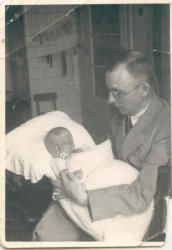
|
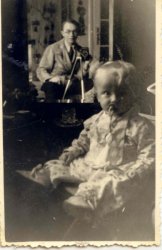
|
Janaszek with his son
Yet, everyday reality of a conspirational family was complicated. The father took a burden of playing an important role in a conspirational organisation on his shoulders. Despite a fact that he was dealing with serious amounts of organisation's funds, material conditions of a four-person-family were very trying. Sometimes a part of salary received due to his function was assigned by major Janaszek - at his family's expense - for the help addressed for dead fellow-companions' widows or the underground's members families that were staying in Nazi prisons at the time.
Actually the whole family participated In the underground activities. The wife was a liaison officer a twelve-year-old daughter would often bring secret materials hidden in two specially prepared cans with Sidol" with opened bottom from one Warsaw's end till another. Even in a several-month-Maciek's pram underground publications, weapons and grenades were sometimes carried.
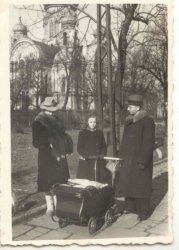
a family photograph with a pram
A small Prague flat of the family was like a barrel with dynamite. All the furniture that was able to be put there, made to order by a conspirational carpenter, was filled with special hiding-places. So, there was a couch with a safe-box installed within, a toilet-table with a false bottom and a chair in legs of which there were holes pasted up with rubber. In both a kitchen cupboard and a bathroom cupboard there were some carpenter's mysteries, as well. All hiding-places were full of weapons, grenades, underground magazines, codes, letters smuggled from prisons, graphs and maps. These hiding-places functioned after the end of the war, too. Thanks to them an occupation archives of "Bolek" was saved. Despite several visits of the Safety Service whose officials wanted to reach it.
The father would bring his daughter Halinka for "excursions". A big doll taken by the girl would accompany them. During these trips the father was observing railway tracks and military transports going by. Then he was making some notes and hid them in the doll. The girl would also keep her father company during trip to the Wall of the Warsaw Ghetto in April 1943. Major Janaszek was analyzing the situation beyond the wall of the fighting Ghetto, wondering how to apply help to Jewish fighters. Several such trials were undertaken, when weapons were given and groups of Jewish soldiers were led out of the Ghetto. Unfortunately, this did not have any influence on the fate of the Ghetto Uprising.
In these cruel times the stiff fighter for the independence of Poland was trying to find at leasr a while for his children, whom he loved very much but for whom, despite trying hard, he devoted too little time. With a thought of a baby son he bought a beautiful edition of "Fairytales from a Thousand and One Night", popularized scientific books by the Lvov School Publishers: "The Hours of Centuries", "The World of Big and Small Things", "Brothers from the Whole World", "From a multiplication table to differential, "Lilavati" and "Following Pythagoras' traces" from the St. Wojciech bookshop. These books, saved from the turmoil of war, together with many others, will begin future passions and interests of the son, including his great love towards the belles-lettres. [Wacław Janaszek] In free time was Reading his daughter classical works of the Polish literature: [those written by] Sienkiewicz, he was teaching her love to Prus, Orzeszkowa, Reymont, Konopnicka and Asnyk. On a Christmas tree from the year 1943 one can admire excellent Christmas decorations hand-made by major Janaszek, Chief of Staff of the Diversion Commander of the Main Command of the Home Army.
His pains did not run to waste. After many years that passed by since that time, his daughter Halina, having graduated from the Warsaw University, became a Slavic Professor and his son Maciej, a graduate of the Warsaw Engineering College, became a master engineer of electronics.
In a period of the years 1943-1944 Kedyw units were conducting a lot of spectacular actions in Warsaw. Many Gestapo torturers from the Szucha Avenue, prison officials from the Pawiak prison and Gęsiówka prison were put to death. Janek Bytnar a.k.a. "Rudy" was delivered from death in the Action by the Arsenal, a fighting-repressive action in Wilanów against volksdeutsch German settlers was also conducted. On February 1, 1944 a General Brigadeführer-SS Franz Kutschera, the SS and the Police commander in Warsaw, directly responsible for the escalation of mass executions of the Polish people, was killed in a street attempt on his life. All these actions were coordinated by the Kedyw command. Colonel August Emil Fieldorf a.k.a. "Nil", lieutenant-colonel Jan Mazurkiewicz a.k.a. "Radosław" and major Wacław Janaszek "Bolek" were the only ones who had a right to sign documents that were received by particular units in the area. The threads of many assassinations were gathered in the hands of the Chief of Staff, among the others these of a famous attack on Kutschera, which was being prepared with proper to him precision, almost pedantry, because each detail was important and to omit any small detail in expectations and calculations might have meant death of many companions.
The Uprising
August 1944 was approaching. As a Staff officer allowed to know the biggest mysteries, "Bolek" knew very well about the military possibilities of Warsaw insurgent units and political realms. He was certain that the uprising that was to break out soon did not have any chances of success without the support of the upcoming Red Army. On the other hand, knowing the fate of the Home Army units on areas occupied by the Russians and about soldiers of the Home Army units taking part in the liberation of Vilnius, he had no delusions regarding Stalin's intentions.
Both his wife and daughter memorized a moment of departing before the Uprising. While saying "goodbye" to his family, going for the "W" hour meeting, he shared his worries.
- The Warsaw Uprising - he said while taking his rucksack on his shoulders, in which there were: reserve clothes, a mess-tin and biscuits - will increase a series of unsuccessful Polish risings, the best Polish youth will bleed to death and only political vultures will be the better for it.
- So don't go - the broken-hearted wife said. - Stay with us on Praga, you will evade this later somehow.
- I am a soldier - Wacław replied. - A soldier's duty is to fulfill his orders. Otherwise he is a traitor and a deserter and he deserves to be shot.
Although such an experienced and knowing the political and military realms officer did not see any special chances for a success of this insurgent impulse, Wacek did not imagine that during these days he could be away from his, often much younger, companions and not supporting them by his experience. He went to fight not because of youth enthusiasm, often naive faith in victory, but due to deeply rooted feeling of duty, feeling of responsibility for his nation, his capital city and for his soldiers. He belonged to the generation of people who would behave "as they would have behaved."
A "Radosław" unit, whose Chief of Staff was major Wacław Piotr Janaszek "Bolek", consisted of elite Kedyw battalions: "Czata 49", "Broom" ("Miotła"), "Umbrella" ("Parasol"), "Fist" ("Pięść") and "Zośka", a "Topolnicki" company, a fighting diversion unit of women "Discus" ("Dysk") and a Kedyw company "A Collegium" ("Kolegium A") At the Uprising's beginning there were about 2,300 soldiers in the Group. A Uprising fighting route leading from Wola through the Old Town, a Czerniaków bridge-head, Mokotów and Śródmieście, was outlived by about 230 soldiers. If so, there were about 90 per cent of casualties compared with the initial number.
On August 1, 1944 at noon in a flat in the Krucza street number 42 in Śródmieście there was a briefing of the "Radosław" unit's command. In the briefing participated the following people: the Unit's Commander-in-chief lieutenant-colonel "Radosław" (Jan Mazurkiewicz), the Chief of Staff major "Bolek" (Wacław Janaszek), the Chief of sanitary authorities major "Skiba" (Cyprian Sadowski),the Chief of Liaison captain "Horodyński" (Wacław Hojna), Brygadier general of "Beard 53" ("Broda 53) captain "Jan" (Jan Kajus Andrzejewski), the Commander of "Umbrella" Battalion captain "Pług" (Adam Borys), the Commander of "Broom" Battalion captain "Niebora" (Władysław Mazurkiewicz), the Commander of a covering party second lieutenant "Tatar" (Franciszek Jurecki), the Commander of the reserve captain "Sawa" (Mieczysław Kurkowski) and the Quartermaster lieutenant "Szczęsny" (Nowosielski). During the briefing the K hour (concentration, Polish Koncentracja) as well as the W hour (outbreak, Polish Wybuch) were given. After some doubts had been established the briefing was finished at 12.25 After that the present people went to their units to give ultimate orders.
A house in the Okopowa street number 16, flat number 17 was set , after previous reconnaissance, to be a place of the command's assembly before the K hour. At that place rules of communication with the Main Headquarters, concerning Doctor "Przemysława" (Zofia Maternowska) and a liaison officer "Małgorzata" (NN). Lieutenant-colonel "Radosław", major "Bolek", major "Igor", the Chief of Sappers, captain "Horodyński", second lieutenant "Tatar" and a chief of conspirational production and munitions second-lieutenant "Rębisz" (Franciszek Hamankiewicz) reported themselves at 4 p.m. at the place of the unit command's concentration in the Okopowa street number 41, at the corner of the Mireckiego street. The command's place of staying was chosen in such a way that it was situated In the middle of the arrangement of the fighting units and, simultaneously, by the main district artery. A quartermaster department was situated in direct neighborhood, in the Okopowa street number 35.
According to initial assignations the place of staying of the Main Headquarters of the Home Army during the Uprising was to be in the southern Mokotów (the Chylicka street) due to closeness to both the broadcasting station and the airport. A "Tower" ("Baszta") regiment and "Radosław" unit with about 4,500 soldiers In total, subordinate to the Main Headquarters of the Home Army were located near by. These were the best armed units and, in addition, in case of "Radosław" - inured in fighting. Apart from being protection of the Main Headquarters a strong reserve that could influence the result of fightings in Warsaw.
In the last moment, on July 29, probably, a decision was made to locate the Main Headquarters with general Bór-Komorowski in a Kamler factory in the Dzielna street and the quartermaster department in a court building in Leszno. Also, the Uprising Commander Colonel "Monter" (Antoni Chruściel) demanded that "Tower" regiment should stay in Mokotów. It caused a need to reorganize liaison and to change tasks for particular units. The Main Headquarters' reserve was divided half to half and, what is more, the "Radosław" unit did not have time to work out new tasks. This had a serious negative influence on the Uprising's course of action. Additional mess was made by concentration ordered by Colonel "Monter" for July 27 and its subsequent annulment. A new disposition given on July 31 at 7 p.m., ordering renewed mobilization and the Uprising's outbreak on August 1 at 5 p.m., was given suddenly, in different conditions and surprised most commanders. In the first phase of the Uprising most units did not reach its personal amount and a part of weapons could not be obtained from conspirational magazines.
The Group's units were located in a following way:
"Beard 53" - a Telefunken factory in the Mareckiego street, a Jewish cemetery and a football field of "Skra" team,
"Umbrella" - an evangelical cemetery, a Calvinist cemetery,
"Broom" - a crossroads of streets: Wolność and Nowolipie and Wolność - Nowolipki number 92 by the Zielna street vis a vis a building of Tabacco Monopoly,
"Czata 49" - an evangelical cemetery and a Calvinist cemetery - a chapel and a grave-digger's house; the rest: the reserve in the Karolkowa street opposite the Calvinis cemetery.
At 5 p.m. "Radosław" units started an offensive to the Okopowa street. The "Zośka" battalion gained barracks in a school building in the St. Kinga street, taking prisoners and gaining a lot of weapons. It also occupied a Pfeifre factory and the Jewish cemetery. Platoons of the battalions "Zośka", "Umbrella" and "Broom", collected on the spot, relieved the Main Headquarters In the Dzielna street, making the Germans retreat. The "Fist" battalion filled the Calvinist cemetery. The "Broom" closed the Okopowa street's outlet, at the cross-roads with the Żytnia street. "Czata" located themselves near by. the "A Collegium" unit gained huge storehouses of food and uniforms In Stawki. A school in the Niska street was captured, from where about 100 Hungarian Jews were set free. At later evening hours major "Bolek" together with "Skała" and with the help of a liaison officer "Jaga" marked out a safe route of communication with the Main Headquarters through roofs, trees and between chimneys. A way straight to the Dzielna street was impossible to go through because of strong firing. During a night "Broom" unit's soldiers conquered the Tabacco Monopoly factory in the Dzielna street. The second company of "Zośka" took a part of a working camp on Gęsiówka between the streets Gęsia and Gliniana together with two guard towers from the side of the Okopowa street.
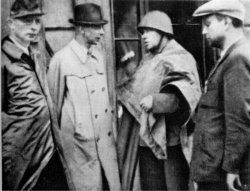
Bor's inspection of the "Radosław" Group
On August 2 a few tanks went into the Okopowa street from the side of the Powązkowska street. During a fight "Zośka" soldiers captured two tanks, which were used in the fight on the insurgents' side. An armoured platoon commanded by lieutenant "Brzoza" (Wacław Micuta) was created. There were fierce fights in the whole district. A "Pine" ("Sosna") unit was trying to capture a school at the corner of the Żelazna and Leszno streets. Lieutenant-colonel "Radosław" engaged the "Broom" to co-operation and he sent "Bolek" for arranging this co-operation.
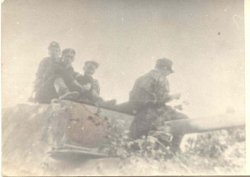
"Panthera" tank gained by "Zośka"
On August 3 and 4 there were still hard fights. On August 4 at 2 p.m. - an offensive against a strong Police group situated on the area of the Ghetto. The battalions "Broom" and "Zośka", with the aid of Uprising tanks and with the help of the units Gustaw" from the direction of Leszno and the Żelazna street as well as the unit Ostoja" took part from the south. Major "Bolek" controlled the operations. German air-raids were holding him back. This attack was to be resumed at 5 p.m. after making the units of captain Sosna" active by major "Bolek." After initial successes the offensive was not effective, which resulted from the lack of co-operation of the units situated from the direction of Leszno.
After information about the enemy's digging passage through a western part of Wola, an urgent thing was to purify the Ghetto of the Germans. The "Radosław" Group was hard hit. A Karol and Maria field hospital was crowded with the wounded. On August 5 from the western side, a huge German offensive started through the streets: Wolska, Górczewska, Żytnia and Długosza. It was stopped, but with many casualties. At 5 p.m. major "Bolek" led a side counter-attack in the direction of the Wolska street, using a part of the following units: "'Fist" "Umbrella", "Czata" and "Zośka". After an initial success the offensive was crushed by huge enemy's fire and after a several-hour-fight the units withdrew for their initial positions. Meanwhile, the "Zośka" battalion, accompanied by the tanks, captured the Gęsiówka camp, setting several hundred of Jewish prisoners free. The Germans who outlived returned to Pawiak. The conquest of Gęsiówka" allowed the "Radosław" Group to communicate with the Old Town.
The overthrow of Wola started. A fragment of a situation report of major "Bolek" from August 8 at 10 a.m. clearly presents threat of the situation:
"The enemy staff of the ST. Zofia hospital (at the corner of the streets Żytnia and Żelazna), having it bombe, moved to a building number 103, hoisting a flag with swastika. From 11 p.m. till 4 a.m. our dropping outposts were waiting for some airdrops In vain. At 3 a.m. a northern section performer an action aimed at an armoured enemy train on a district line, the aim of which was to destroy it. The action did not work - we lost six killed people, two submachine guns and two our people were wounded. It was stated that a district line in this section was insured by a constant line of strengthened outposts equipped with machine guns and Ligot field guns. During a night there was silence in this area.
At 6 a.m. attacks on our barricades started at the corner of the streets Żytnia and Karolkowa as well as the streets Żytnia and Okopowa. Till 9 a.m. four offensives were forced back (3 of which in the Karolkowa street). The enemy lost 14 people. On the Karolkowi street the retreating infantry was making civilians followed them as its shelter. The Calvinist cemetery, occupying a very little area and heavily firing, is not filled with anyone - we are inspecting it by means of observation and patrols The defense of the Evangelical cemetery was based on little fighting groups, working on base of traps. A section's commander keeps the reserve in his hands. At 7.50 five armoured enemy cars were noticed while approaching "Naftusia" on the outer side of the district line in the direction of the Górczewska street. 9 a.m. - the enemy is broadening the point of pressure from the west, that had reached the Evangelical cemetery so far; the enemy started to fill with people the houses deep into the Sołtyka street opposite the Jewish cemetery. Our barricade was under huge fire.
Ordered observation of the section Wolska-Chłodna did not give any particular effects due to fires and the fact that the Leszno line had been filled with the enemy. We know only thanks to accidental passers-by that some minor enemy elements are going to west. An ordered task of broadening its extent for Leszno and the Wolska street and building a barricade there is unrealizable because of catastrophic state of ammunition. I would have to use half of our ammunition for that, taking it from the first line riflemen. It would threaten with a catastrophe, as in case of the enemy's breaking somewhere I would not have intervention fire reserve at all. To transmit to evacuation enemy movements on this route will make the enemy concentrate its whole effort to break my group, to which I cannot admit at all cost.
Atmosphere in our units - a general mood is pessimistic, full of disappointment because of lack of means of fight lasting for the eighth day. We are fighting without any help, either from our own quartermaster department or our allies. This situation brings a difficult problem to be solved - what to do with fighting soldiers when the supplies of ammunition would be totally used - and this must happen during next few days.
Another problem is a matter of civilians who till now were protected by the army, despite hard conditions. I find it shameful that so far nobody from the Government Representation has appeared in the terrain of fights to deal with the people's fate. Soldiers can see that and comment in a proper way. I do not know the situation in the Old Town. However, I claim that from that district an unit of about 200 people, partially armed, came to my terrain (the Gęsia street),commanded by some "Wilnianin", so I can think that atmosphere of uncertainty and depression is being created there. On a protruding outpost, where - due to this or that course of action - I have to be responsible for the fate of thousands of civilians and soldiers, I must be oriented in a general state in the most precise way.(...)"
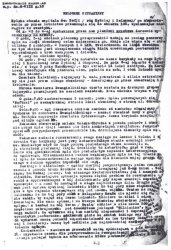
a report of major "Bolek" from August 8, 1944, 10 a.m.
On captured areas the Germans were slaughtering civilians, by killing fifty thousand people. Soldiers of the "Radosław" Group, in a constant fight, were being pushed at the direction of Stawki and the Old Town. A battle of the Okopowa street and the cemeteries was being fought. On August 11 the "Broom" battalion suppressed a German offensive by the Parys square and storehouses' gate in Stawki. In a direct battle in a deadly fire of machine guns captain "Niebora" died (a brother of "Radosław") and "Radosław" himself was seriously wounded. The "Broom" battalion lost almost halfo f its personal Mount and many officers were killed. Major "Bolek" took over the command of the "Radosław" Group at 11 o'clock.
Major "Bolek" reported at 12 o'clock:
The situation on a northern flank of our section became under control. The terrain of Stawki is in our hands. We are capturing the Szczęśliwa street, the Parys square, the corner of the Okopowa and the Powązkowska streets. A very strong mortar and artillery fire (tanks from the area of Powązki) is directed on the school in the St. Kinga street and the Pfeifer factory; neither attack from the western direction does not work so far. Due to a lot of casualties among officers I'm doing the re-organisation of command. I want to keep the whole area today. A state of lieutenant-colonel Radosław - there is no threat to his life. I am evacuating him to the Jan Boży hospital. The "Broom" commander captain Niebora is dead, as well as two officers. I'm urgently asking for ammunition. We need it for a mortar 81 mm (a German bomber).
Commander of Radosław group
Major "Bolek"
a report of major "Bolek" from August 11, 1944, 7 p.m.
By making the Germans tied with the fight the units of the "Radosław" Group were retreating in the direction of the Old Town. The Main Headquarters of the Home Army was moved to the Krasiński Palace in the Długa street number 7.
meldunki mjr "Bolka" z 12 sierpnia 1944 r.
Tired and weak, "Radosław" units were occupying the defense lines of the Old Town from the direction of south-west. After August 13 the Group commanded by major "Bolek" occupied a block of buildings between the streets: Żoliborska, Pokorna, Muranowska, Przebieg and Bonifraterska. 659 soldiers including 56 officers reached the Old Town from Wola. The Group's command was stationed in the Muranowska street initially and then it was moved to the Mławska number 5.
All the time fierce enemy attacks from the side of Traugutt fort, the Gdańsk Railway Stadion and Stawki were being repelled. On August 14 major "Bolek" threw the reserve to an offensive, making the enemy step back to Stawki, with casualties. There were another casualties in the Group: the killed and the wounded. All the time there lasted a great enemy offensive to the Old Town. On August 15 lieutenant-colonel "Radosław" made a proposal for the promotion of major Wacław Janaszek "Bolek" to the rank of lieutenant-colonel.
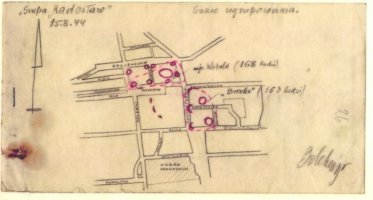
a situational sketch of the "Radosław" Group's position on August 15,1944, made by major "Bolek"
During the night of August 21 and 22 an offensive in the direction of the Gdański Railway Stadion was realized from two directions: Żoliborz and the Old Town. The aim was to make two fighting city districts connect. The offensive from the side of Żoliborz started about 2.30 a.m. "Żywiciel" units of abort 300 soldiers and about 650 soldiers of the Group of major "Okoń" that went from the Kampinos Forest took part in it. The attack started without necessary synchronization. The insurgents found themselves in deadly fire from the Cytadel and from an armoured train and also from the Traugutt square. The offensive from the Old Town started some time later, at 3 a.m. The companies of the "Zośka"and "Czata" battalions as well as this of lieutenant "Konrad" from the People's Army participated - about 350 people in total. Major "Bolek" was commanding the whole offensive from the side of the Old Town. Having entered a "Polonia" football pitch, the attackers founded themselves In cross-fire from the Traugutt fortress and the Citadel. Moreover, the attackers were hit by side fire from the Legions fortress and from the side of the Ghetto. The units suffered great losses and they retreated in the morning for the initial positions.
The offensive finished with a total defeat. The insurgents lost about 500 killed or wounded people. The hope for uniting the Old Town and Żoliborz disappeared. One of the defeat's reasons was too quick an attack and inability of the Forest units to fight in a town. Both sided attacks were not conducted synchronically. Communication between Żoliborz and the Old Town fell short of expectations. Radio communication between "Wachnowski" and "Żywiciel" was not direct but through a radio centre of the Main Commander in Stanmoor near London.
In the meantime the Group's command moved from the Mławska street, where ad stance from the defense line was 60 meters, to the Koźla street number 7. On August 25 about 10 a.m. a heavy mortar's bullet fell on a building where the command was stationed. Major "Bolek" was seriously wounded. This explosion pulled out almost whole his calf. Captain "Sawa" lost his foot. Four liaison officers were also seriously wounded and captain "Horodyński" was shell-shocked. The wounded were transported to a field-hospital in the building of the Main Archive of Old Data in the Długa street number 24, where "Bolek" underwent an operation. At the same time the Old Town was dying out. Suddenly the hospital building was occupied by the Germans. Infernal scenes were visible there because bandits of a Dirlewanger group started to murder other Polish people. Yet, in the hospital wounded SSmen were staying, who, previously looked after by Polish doctors and nurses, stood up for the Polish people. Soon afterwards the hospital was recaptured by the insurgents.
German units around the Old Town were tightening systematically. The units of the "Radosław" Group were retreating in the direction of the Krasiński square, where a manhole to an evacuation ditch was situated. During the night of August 31 and September 1 a part of the "Zośka" battalion, in battle array went through German positions in the Saski Garden and reached the Polish posts in the area of the Zielona street. The rest of the Group left the Krasiński Square and went to the Nowy Świat near the Warecka street by means of ditches during the night of September 1 and 2. The seriously wounded major "Bolek" and captain "Sawa" were evacuated from the Group. Jewish volunteers who had been set free from Gęsiówka by "Zośka" carried them on stretchers. The wounded did not feel the awfulness of a ditch wander. Both were unconscious and had high fever. They were obtained from the manhole in the Warecka street together with their soldiers.
The rest of the Group after two days of rest was led to the Czerniaków outpost, to continue their deadly route. Both wounded higher officers were transported to a quite far-away field-hospital in the Drewniana street number 8 in Powiśle that had been organized in a school building. What were the reasons for such an incomprehensible decision? After all, a hospital in the Konopczyńskiego street number 7 was very close. Was it organizational mess or bad will? A commander of liaison officers of the Group, captain "Irma" (Anna Mazurkiewicz) immediately after hearing the news of the two wounded officers' fate, sent a sanitary patrol in the direction of the Drewniana street, with an order to carry them back. Unfortunately, it was too late. A huge German assault were coming to Powiśle whose aim was to detach Śródmieście from the Vistula river. On September 6 and 7 Powiśle gave up. The hospital in the Drewniana street became in the German hands. Lightly wounded people had been evacuated before. Seriously wounded ones had stayed. According to witnesses' reports, a supervising doctor ceased the full hospital's evacuation. His seriously wounded mother was staying there and he was afraid of her state of health during evacuation.
Wounded insurgents got rid of their arm-bands and helmets and the hospital was reported to the Germans as a civil one. They understood this on the surface but the next day they threw, as if by accident, a grenade on a floor where beds were staying. The hospital staff carried the wounded to a cellar where the people were put in straw mattresses on the floor. A nurse Romana Kurkowska, a captain's "Sawa" wife, was looking after "Bolek" and "Sawa". In the Drewniana street "Bolek" underwent a long operation. His wound was healing well, which was a chance to come back to full health.
The hospital was kept in uncertainty during the next days, on a nobody's terrain. According to witnesses' reports, in some sense a Wehrmacht soldier, a Silesian man was looking after it. He would bring food and console the patients that the Russians would come soon and set them free. Such state of affairs lasted until September 27. On that day, when Mokotów gave up and the Germans murdered helpless captives in the Dworkowa street, about 2 p.m. ruffians of a fighting SS-Gruppenführer Heinrich Reinefarth group dashed into the hospital. Among yells and beating they ordered the staff to leave to a courtyard and stand with their faces to a wall. They ran to the cellars where the wounded were lying. After a while shots met the ear... When the murderers went to the courtyard again, their rifles' barrels were still steaming. While shouting "We will make a crematory here", the criminals ran to a garden nearby the school and shot two nurses in a summer-house. At that time Romana Kurkowska who was still untiringly looking after his husband captain M. Kurkowski and major W. Janaszek, went to the cellar to see what had happened with the wounded. She saw an awful sight. All the wounded were dead. Above each bed-head there were bloody stains. Captain Kurkowski "Sawa", who had been lying closer to an entrance, was murdered first. His head was torn to a mummy because the murderers were shooting from big caliber weapons (after the Warsaw liberation shells of caliber 9 mm were found). Major Wacek Janaszek "Bolek" was ling in the second bed in a row. One of the insurgents probably in a moment of this execution jumped to his feet at the end of his tether and rushed to a passage connecting a hospital room with a small kitchen because his dead body was lying there. Romana Kurkowska was trying to take off his husband's hand token of remembrance which she held dear, a wedding ring and a watch. But a German who appeared in the cellar did not allow her to do that. Among the murdered people there was also a wounded young insurgent from a "Genowefa" company of a 'Gustaw-Harnaś' battalion, Konrad Eryk Lisiecki a.k.a. "Pistol" ("Pistolet"). Next to him his shot mother, Nadzieja Lisiecka, was lying. She was looking after the boy and was desperately trying to stop a bandit.
After the execution petrol was poured on the dead bodies and they were burnt. The hospital staff was put by the wall where it was waiting for the execution. A moment before this a German officer appeared and he suspended the execution. The saved people were driven together with a group of saved civilians.
In November 1944, several months after the Uprising downfall, a brother of the boy murdered in the Drewniana street hospital, Jerzy Lisiecki, who was also a soldier of the "Genowefa" company, a.k.a. "Jerzy II", who was lucky to avoid the captivity, reached Warsaw from Pruszków by means of a cart under a pretext of resumption of a Śródmieście workshop appliances.. Having heard from the witnesses about the tragedy he reached the Drewniana street. Carbonized corpses were still lying in the place of the execution. They were hardly distinguishable. He recognized his mother, half-Greek, thanks to her beautiful black hair with a characteristic strip of grey hair that she had had since early youth. Not earlier than in February 1945, after the Warsaw deliberation, the dead bodies of the murdered people were buried in a common improvised grave on the other side of the Drewniana street number 7.
In May 1945 the killed people's families gathered by the dug hole in the ground. Remains of the dead bodies were taken from this huge cave, in an advanced state of decomposition, and claimed the ones of their close ones by the relatives thanks to recognition of fragments of clothes or teeth. These remains were put into boxes, preparing them to a journey. Two joined bodies both widows recognized as their husbands', "Bolek" and "Sawy". It was probably an explosion of a grenade thrown between bodies poured with petrol that joined them in the last hug. The widows decided that their husbands, life companions, would rest after death in a common tomb.
When a nightmarish action was finished, a long cart procession set off to the military Powązki cemetery. Some time later one of major's "Bolek" subordinates, scoutmaster captain Andrzej Romocki a.k.a. "Morro" carried by his friends from the "Zośka" battalion started his last journey from near-by Czerniaków...
The Epilogue
Major of sappers Wacław Janaszek "Bolek" died, not living till the age of 41. He left a 28-year-widow, a 14-year-old daughter (from his first marriage) and a 1,5-year-son. He was posthumously promoted to the rank of lieutenant-colonel of sappers in the constant service. For his merits and military virtues he was given the Cross of the Brave three times as well as the Silver Cross (5th class) of the Military Order Virtuti Militari posthumously (number 13005 of an order. 512/BP from October 2, 1944 .). His name appears on a commemorating plate in the St. Antoni Church in the Senatorska street number 31 and on the Memory Wall of the Warsaw Uprising Museum. Maciej, the son of "Bolek unveiled a commemorating plate in a primary school number 41 in the Drewniana street number 8 where the field-hospital was situated during the Uprising.
school building on 8 Drewniana str.
Lieutenant-colonel "Bolek" and major "Sawa" (posthumously promoted) lie in a common tomb in the Military Powązki Cemetery in the battalion' "Broom" cemetery section number 24A.
a tomb of "Bolek" and Sawa"
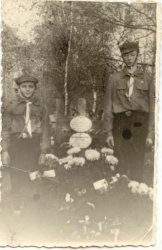
Maciej and Mietek - by their fathers' tombs in 1959
Next to them graves of major Władysława Mazurkiewicz "Niebora", general Jan Mazurkiewicz""Radosława" and captain. Anna Mazurkiewicz "Irma" are situated.
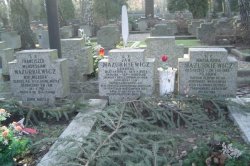
graves of Mazurkiewicz family
In a distance of a dozen or so meters from their grave there stands a rough obelisk, erected for commemoration of the heroes killed during the occupation and the Warsaw Uprising, having a Virtuti Military Cross on it as well as a moving inscription "Gloria Victis" - "Chwała Zwyciężonym" ("Glory to the Defeated").
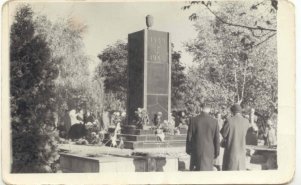
former
|
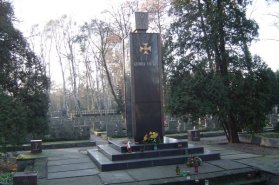
now
|
Gloria Victis obelisk
Two Kedyw of the Main Headquarters of the Home Army commanders, direct superiors of "Bolek" had to share a fate in dark realms of the Polish after-war history.
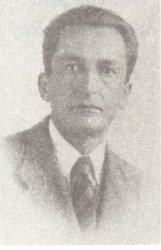
a photograph of Fieldorf
General Emil August Fieldorf a.k.a. "Nil", arrested in March 1945 under another name, unrecognized, was transported to a NKWD camp in the middle of Russia where he was staying till the year 1947. Having come back to Poland, he was again arrested by the Safety Office in 1949. He was sentenced to death in a disgraceful trial and on February 24, 1953 he was killed in a Mokotów prison in Warsaw. It not has been established by now where the dead body of general "Nil" had been buried. His good name was restored posthumously in 1957. A symbolic tomb, funded in 1972 by a contemporary Minister of the National Defense general Wojciech Jaruzelski, is to be found in a cemetery section number 14A in the Military Powązki Cemetery.
a tomb of Fieldorf
General Jan Mazurkiewicz "Radosław" was arrested by the Safety Office on August 1, 1945.
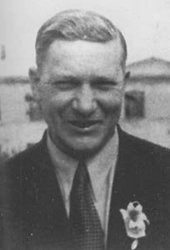
a photograph of Mazurkiewicz
After a short stay in prison he was released. Then he made an appeal to the Home Army soldiers to come from the underground. On February 1949 he was arrested again. He was staying in a Mokotów prison till the year 1956, from where he was released as a result of amnesty. He was rehabilitated in the year 1957.
Second-in-command of Kedyw of the Main Headquarters of the Home Army Colonel Franciszek Niepokólczycki a.k.a. "Teodor" was arrested by the Safety Office in October 1946.
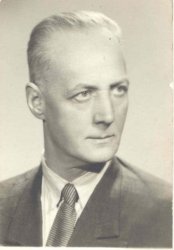
a photograph of Niepokólczycki
|
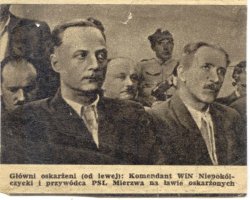
a trial
|
Sentenced to Heath, wchich then was changed into life sentence, he was staying in prison till the year 1956. He was set free as a result of so-called "Thaw" ("Odwilż") in December 1956.
On October 2, 1979 lieutenant-colonel Wacław Janaszek "Bolek" was posthumously given a Commemorative Order of the "Radosław" Group.
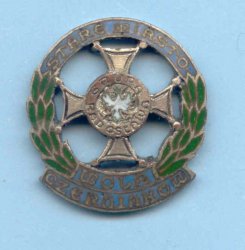
a "Radosław" Group order
On February 8, 2002, after several dozen years from the moment of the distinction his adult son Maciej officially received from the Combatant Office a Virtuti Military Order awarded to him in the year 1944.
Virtuti Militari diplomas and card
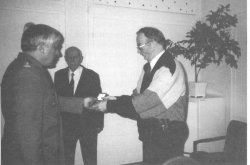
the son is taking his father's VM
In the year 2004 a former roundabout Babka in Warsaw, situated nearby the Gdański Railway Station, was given a name of the Roundabout of the Soldiers of the Home Army's Group "Radosław". On August 10, 2004, at the time of the sixtieth anniversary of the Warsaw Uprising a long awaited commemorating plate devoted for the "Radosław" soldiers was unveiled by the roundabout. During the solemn Reading of the roll of the dead lieutenant-colonel Wacław Janaszek "Bolek" was also mentioned among the Group's soldiers.
compiled by: Maciej Janaszek-Seydlitz
Halina Janaszek-Ivaničkova
P.S. The fate of the hospital in the Drewniana street number 8, supervised by Doctor Staszewski is mysterious. We only know six names of the victims buried in graves in the Military Powązki. These are: "Bolek", "Sawa", Nadzieja and Konrad Lisiecki and Maria and Irena Grabusińska. The bodies of the other several dozen people, taken during the exhumation in spring 1945, were put in three big coffins and labeled NN (unknown). Now they are in a common tomb in a cemetery section number 22A (next to a grave of K.K. Baczyński) where the Lisiecki and the Grabusiński families are buried.
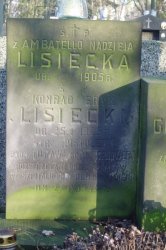
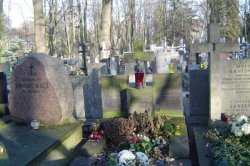
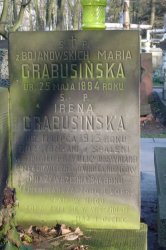
a grave of the Lisiecki family
During the several dozen years that passed by since the tragedy in the school in the Drewniana street nobody looking for some trace of their close people turned up. We do not know whether the hospital records with a list of patients were saved or not.
Maybe someone reading this biography will bring something new to the case.
translated by Monika Ałasa
Copyright © 2007 Maciej Janaszek-Seydlitz. All rights reserved.




